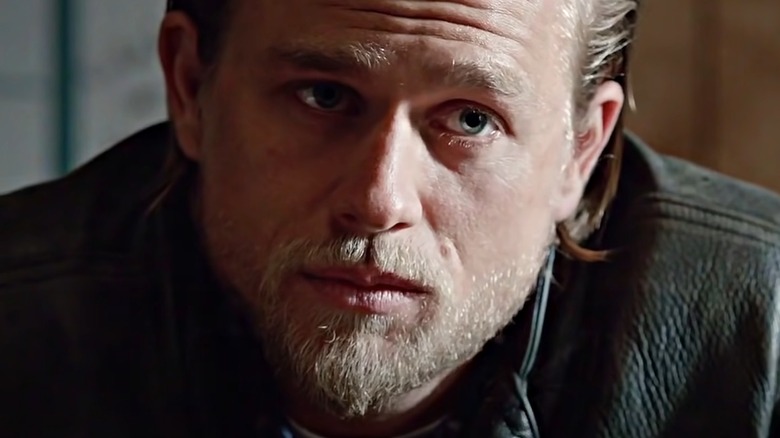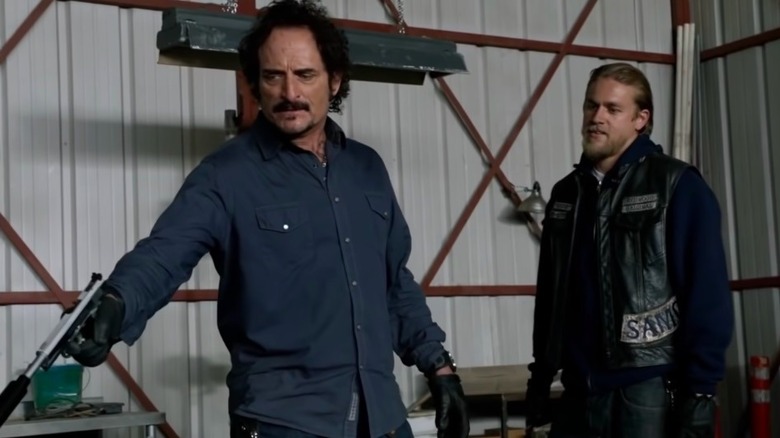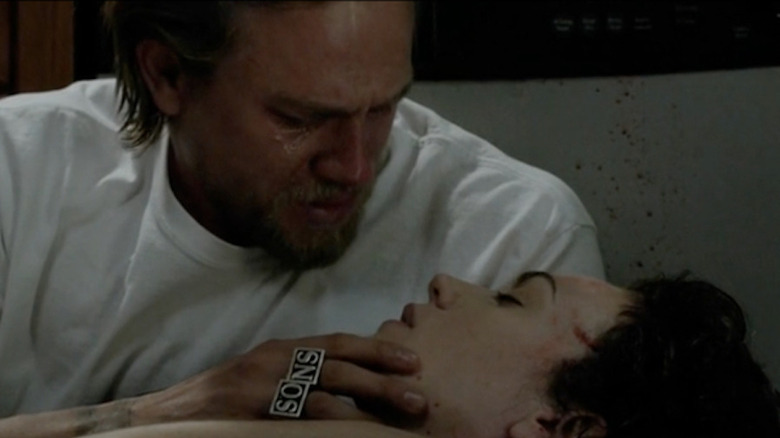The Behind-The-Scenes Drama That Almost Changed Sons Of Anarchy Forever
"Sons of Anarchy," the action crime drama about an outlaw motorcycle gang called SAMCRO (Sons of Anarchy Motorcycle Club, Redwood Original), ran for 7 seasons on FX from 2008 to 2014. Created by Kurt Sutter, the series centers on Jackson "Jax" Teller, (Charlie Hunnam), the vice president (and, later, the president) of SAMCRO, as he questions the club while simultaneously keeping it afloat after the death of its founder, his father John Teller. Other major players include Jax's stepfather Clay Morrow (Ron Perlman), Jax's mother Gemma Teller Morrow (Katey Sagal), Jax's love interest Tara Knowles (Maggie Siff) and Jax's childhood best friend Opie Winston (Ryan Hurst).
As a viewer, you may expect a lot of violence, gore, and profanity on "Sons of Anarchy," seeing as the entire series focuses on the inner workings of a gang. However, as you watch, you may start to question just how far some "SOA" scenes go — essentially, the series never held back when it came to graphic scenes depicting the violence, including many deaths, that occurred in the show's seven seasons. From Tara's tragic death to the burning of Kyle's (Brian Van Holt) tattoo, "Sons of Anarchy" is full of unforgettable, brutal moments.
Yet, the violence and language of the show was almost very different due to some behind-the-scenes drama — here's how "Sons of Anarchy" could have been changed forever.
Kurt Sutter fought to keep SOA's racy elements
As it turns out, some of the more graphic scenes weren't exactly easy to get on screen, nor was some of the characters' more colorful language. Speaking with Entertainment Weekly in 2014, showrunner Kurt Sutter revealed the challenges behind making such a racy show for a network. Sutter began by explaining that because the Standards & Practices frequently changed, he constantly had to adjust and fight for various moments of violence or profanity.
Giving an example, Sutter explained, "'Jesus Christ' is basically my [F word], because I can't say [the F word]. And there was one season where they were, like, counting my 'Jesus Christs' because somebody on the Fox food chain thought it was so blasphemous. It's the kind of thing where I'll find some kind of compromise where I'll fight for a couple and pull one out."
Meanwhile, FX Networks CEO John Landgraf provided EW with his own example of a time when Sutter refused to back down from — and won — a disagreement over a certain moment of violence: the explicit castration of a pedophile clown. "I had a huge knockout, drag down fight with Kurt ... [about] whether we would allow him to show the removed part landing on the ground," Landgraf said, explaining, "I totally acknowledge the need for violence. It's a violent world and a violent show. He's portraying really tragic, dark consequences of violence. Kurt wants to show it in very graphic detail, and I want to leave more to the imagination."
Sutter has insisted the violence is necessary on more than one occasion
In 2012, the Los Angeles Times published a piece titled, "Has FX's 'Sons of Anarchy' become TV's most violent show?" Writer Greg Braxton explored how "Sons of Anarchy" had seemingly gotten more violent and graphic over the years — and gave Sutter another opportunity to explain why he found the increasing violence so necessary to the story he was telling.
Sutter explained that when Jax moved up in rank, going from vice president to president of SAMCRO, so did the possibility of him finding himself in dangerous situations. Sutter said, "We really wanted to turn the heat up on Jax and show the point of view of a very dangerous existence. For me it was about shining a light on the very dangerous nature of the world. Nothing was done to shock, but we turned up the level of violence to expose him to all those things that I knew would influence his ability to make a decision."
Fans of "Sons of Anarchy" would likely agree that it's hard to imagine the series without the many graphic moments, as it reflected the reality of the story it was telling. Luckily, Sutter was able to showcase the type of scenes he found necessary so that "Sons of Anarchy" didn't turn out to be an entirely different show.


